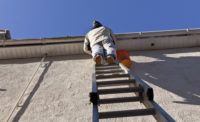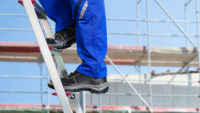Ladders 1926.1053 was the sixth most-frequently cited agency standard in FY 2019.
Enforcement citations FY 2019: 2,582
Number of inspections: 2,135
Proposed penalties: $6,322,138
Most frequently cited industries
Specialty Trade Contractors and Construction of Buildings earned the lion’s share of OSHA citations for violations of standard 1926.1053, with employers in the first category accruing 2,282 citations from 1,898 inspections, resulting in $5,684,448 in proposed penalties, and employers in the second, Construction of Buildings, being cited for 211 violations arising from 169 inspections, with proposed penalties of $456,163.
Heavy and Civil Engineering Construction was in third place, with 39 citations, 31 inspections and $65,983 in penalties, followed by Merchant Wholesalers, Durable Goods (18 citations, 11 inspections, $36,083 in penalties); Utilities (four citations, three inspections, $11,987 in penalties); and Administrative and Support Services (four citations, three inspections, $7,492 in penalties).
Real Estate employers were inspected three times in FY 2019, resulting in three citations and $14,624 in penalties. The Accommodation (three citations, one inspection, $3,500 in penalties); Electrical Equipment, Appliance, and Component Manufacturing industries (two citations, two inspections, $4,131 in penalties) rounded out the top ten violators list.
Key provisions
1926.1053 requirements apply to all ladder types, including self-supporting portable, not self-supporting portable, fixed and job-made. The standard specifies the load sizes that each ladder type must be capable of supporting without failure. It also spells out spacing for rungs, cleats and steps, which must be parallel, level, and uniformly spaced when the ladder is in position for use.
Other requirements: the rungs of individual-rung/step ladders shall be shaped such that employees' feet cannot slide off the end of the rungs; the rungs and steps of fixed metal ladders manufactured after March 15, 1991 and portable metal ladders, shall be corrugated, knurled, dimpled, coated with skid-resistant material, or otherwise treated to minimize slipping; and ladders shall not be tied or fastened together to provide longer sections unless they are specifically designed for such use.
Ladder components shall be surfaced so as to prevent injury to an employee from punctures or lacerations, and to prevent snagging of clothing and wood ladders cannot be coated with any opaque covering, except for identification or warning labels which may be placed on one face only of a side rail.
When two or more separate ladders are used to reach an elevated work area, the ladders must be offset with a platform or landing between the ladders – except when portable ladders are used to gain access to fixed ladders (such as those on utility towers, billboards, and other structures where the bottom of the fixed ladder is elevated to limit access).
An exception
Vehicle-mounted fixed ladders are not covered by the standard, as explained in a letter of interpretation written by then-OSHA Director of Directorate of Construction Russell B. Swanson in 2001. Swanson wrote that the definition of a fixed ladder used in 1926.1050, a final rule published by OSHA in 1990, is "a ladder that cannot be readily moved or carried because it is an integral part of a building or structure." Because OSHA did not address fixed ladders on vehicles in that rule, “the provisions in §1926.1053 regarding fixed ladders do not apply to fixed ladders on vehicles.”2
Why a standard?
OSHA’s priority on ladder safety is understandable; falls from ladders accounted for 104 work-related deaths in 2016. According to the National Institute for Occupational Safety and Health (NIOSH), 57 percent of those fatalities occurred in the construction industry.1
Factors that contribute to falls from ladders include: worker inexperience or lack of training, improper ladder selection, the improper use of a ladder, ladder overloading, a ladder not being set up on a flat, level surface or at a proper angle, not extending the ladder above the roof line, and lack of safe access.
Two ladder fatalities
Two NIOSH Fatality Assessment and Control Evaluation (FACE) reports illustrate the dangers of falling from ladders – even one at a relatively low height. In one incident, in 2017, a 49-year-old carpenter employed by a residential contractor in Massachusetts was fatally injured after falling from an extension ladder. The victim and a co-worker were onsite to perform gutter work on a house. The victim was climbing an extension ladder that was set up on stone pavers to access the roof. While the carpenter was climbing the ladder, the base of the ladder slipped and the ladder fell to the left. The carpenter fell to the ground and died of his injuries 16 days later. An investigation into the incident found that it was caused by an incorrect ladder type/duty rating being used; the ladder being overloaded; and the ladder being set up on a surface that was not flat.
In another ladder-related fatality, a worker was on an eight-foot step ladder, cleaning windows. The worker failed to maintain three points of contact with the ladder and fell to the ground, hitting his head.
Preventive measures
In addition to complying with the standard, there are additional steps you can take to prevent falls from ladders. NIOSH recommends training employees on how to properly use ladders; choosing the right ladder for the job; inspecting ladders regularly to ensure they are in good working order; making sure you use a ladder on flat and level ground; securing and positioning the ladder in the safest location possible; extending the side rails of the ladder three feet above the roof edge; facing the ladder at all times when climbing; maintaining three points of contact with the ladder at all times and not overloading a ladder. NIOSH also offers a Ladder Safety App to help users set the proper ladder angle.
Resources
Stairways and Ladders, a Guide to OSHA Rules, Publication 3124. This booklet published in 2003 provides a general overview of the standard and requirements.
OSHA Quick Card: Portable Ladder Safety. This informative tip sheet offers instructions on preventing falls from portable ladders.
References
|
2020 Top Standards Article Index ANSI/ISEA 121- Dropped object prevention solutions NFPA 652 standard on fundamentals of combustible dust OSHA most frequently violated standardsFall protection- General Requirements (1926.501) Hazard Communication (1910.1200) The Control of Hazardous Energy (Lockout/Tagout) 1910.147 Respiratory Protection (1910.134) Powered Industrial Trucks (1910.178) |






